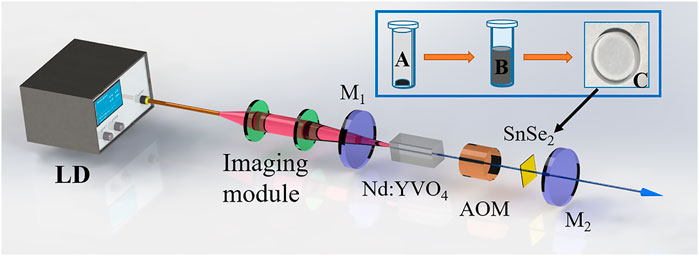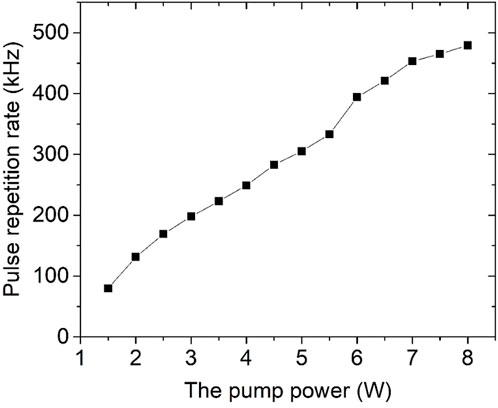- School of Physics, Changchun University of Science and Technology, Changchun, China
By simultaneously employing self-made SnSe2 saturable absorber (SA) and an acous-to-optic modulator (AOM), a dual-loss-modulated Q-switched Nd:YVO4 laser with short pulse width, high peak power and adjustable pulse repetition rate is presented. The maximum pulse peak power of 37.57 KW with the minimum pulse duration of 5.52 ns were obtained under the pump power of 8 W and the pulse repetition rate of 5 kHz. The experimental results demonstrate that the dual-loss modulation technology with AOM and SnSe2 SA is a simple and efficient method to generate short pulses with high peak power and adjustable low repetition rates.
1 Introduction
Stable solid-state pulsed laser sources with large pulse energy and peak power are used in a variety of applications, ranging from basic research to industrial material processing, medicine and telecommunications [1–3]. The use of a saturable absorber (SA) to generate pulsed lasers has been the most popular approach nowadays. In recent years, stimulated by the successful application of graphene, many two-dimension (2D) materials with layered structure have been rediscovered as promising and interesting SA materials due to their advantages of ultra-fast recovery time, broadband saturable absorption and simple fabrication process [4–7]. Tin diselenide (SnSe2), an environmentally friendly and earth-abundant material, as a member of the 2D materials family, has gained wide attention in communications, microelectronics, lasers and nonlinear optical fields due to its unique properties, low toxicity and low cost [8, 9]. Because of the adjustable band gap characteristics, SnSe2 has obvious broadband saturable absorption characteristics. The indirect band-gap of few layers and large bulk SnSe2 ranges from 1.07 (∼1159 nm) to 1.69 eV(∼734 nm), corresponding to the direct band-gap ranges from 1.84 to 2.04 eV, respectively [10]. The indirect band-gap of few layers SnSe2 indicates the ability of the SnSe2 saturable absorber at 1 μm. The nonlinear optical property of multilayer SnSe2 at 1 μm was first reported by Cheng et al in 2017, a passively Q-switched waveguide solid-state laser based on SnSe2-SA was achieved with a minimum pulse width of 129 ns and pulse energy of 6.5 nJ [10]. In 2018, Zhang et al. reported a high power passively Q-switched Yb-doped fiber laser based on SnSe2-SA [11]. So far, the nonlinear optical response of SnSe2 has been widely studied by Q-switched or mode-locked lasers of different wavebands [12–15]. However, researches on pulse modulation characteristic of SnSe2 in solid-state laser is not enough.
As we know, using the dual-loss modulation mechanism, the poor stability and the difficult controllability of pulse characteristics in singly passively Q-switched lasers can be significantly improved [16–19]. Especially in the active-passively doubly Q-switched laser, the pulse duration can be compressed greatly to shorter than that of single passive modu-lated laser, while the pulse repetition rate can be controlled by the active modulator. Thus, pulses with high peak power, controllable repetition rate and excellent stability could be expected. However, there is no report on SnSe2 for all-solid-state dual-loss modulation Q-switched lasers at 1.06 μm.
In this work, with our self-made SnSe2-SA and an acous-to-optic modulator (AOM), a diode-pumped doubly Q-switched laser was presented. With the maximum pump power of 8 W and AOM repetition rate of 5 kHz, the maximum pulse peak power of 37.57 KW with minimum pulse duration of 5.52 ns were obtained. For comparison, the output performances of single passive Q-switched laser with SnSe2-SA and single active Q-switched laser with AOM in our experiment were also investigated.
2 Preparation and Characterization of Few-Layered SnSe2-SA
The SnSe2 nanosheet we used as SA was fabricated by the liquid-phase exfoliation method. 30 mg SnSe2 powder and 10 ml absolute ethylalcohol were mixed in a centrifuge tube. After 12 h sonication process, the SnSe2 dispersions used in our experiment can be obtained. In order to fabricate evenly distributed SnSe2 film, the spin coating method was used to prepare SnSe2 SA. 10 μl dispersions was absorbed by suction pipet and dripped onto a quartz plate with a size of 30 mm × 30 mm × 0.5 mm. The quartz substrate was placed in the center of a spinner with a speed of 300 rpm. Soon, the SnSe2 dispersions on the substrate was dried and a high quality SnSe2-SA was well prepared.
The flake thicknesses of SnSe2 were measured via atomic force microscopy (AFM), which is shown in Figure 1A. The corresponding height profile, presented in Figure 1B, shows the average thickness of ∼6 nm, corresponding to about ∼10 layers [10].
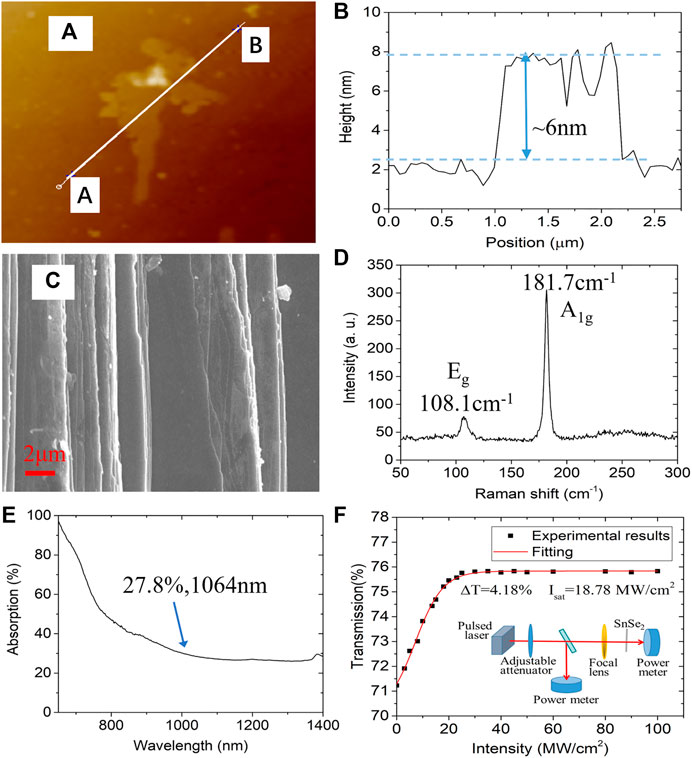
FIGURE 1. (A) AFM image; (B) the corresponding heights of the AFM image; (C) SEM image; (D) Raman spectrum; (E) Absorption spectrum of the SnSe2 film; (F) Nonlinear transmittance curve of the SnSe2-SA.
The AFM is still not intuitive to observe the layered structure of the SnSe2 SA. Therefore, the microstructures of SnSe2 were recorded by a scanning electron microscope (SEM) with an optical resolution of 2 μm, shown in Figure 1C. From the figure, it can be found that well-layered structure of the SnSe2 nanosheets were prepared in our work. The Raman spectrum was recorded and shown in Figure 1D, which demonstrated the atomic structural arrangement of the fabricated film. From the figure, the Eg mode and the A1g mode can be observed and located at 108.1 cm−1 and 181.7 cm−1, respectively. The linear absorption of SnSe2 was measured by a Hitachi U-4100 spectrophotometer and shown in Figure 1E. One can see the SnSe2 film possesses broadband absorption characteristics and the measured absorption of the SnSe2 film was 27.8% at 1,064 nm. In order to confirm the saturable absorption capability of the SnSe2-SA sample near 1 μm, the nonlinear transmission was measured and given in Figure 1F. By fitting the experimental data, the modulation depth and saturation intensity were determined to be 4.18% and 18.78 MW/cm2, respectively.
3 Experimental Setup and Results
3.1 Experimental Setup
The schematic of the doubly Q-switched laser with AOM and SnSe2-SA was demonstrated in Figure 2. Mirrors M1 and M2, acting as the resonator mirrors, are both plane mirrors. M1, as the input mirror, is high antireflection (AR) coated at 808 nm and high-reflection (HR) coated at 1,064 nm. The transmittance of the output mirror M2 is 15% at 1,064 nm. A 3 × 3 × 6 mm Nd:YVO4 crystal, which is AR coated at 808 and 1,064 nm on both light-pass faces, is used as the laser medium with the Nd-doping concentration of 0.5 at. %. The laser is pumped by a commercial fiber-coupled diode laser at 808 nm with a 1:0.8 optical coupling system. An acousto-optic modulator (AOM) (GOOCH & HOUSEG) is employed as the active modulator. The total cavity length is about 13.5 cm, which refers to the distance between M1 and M2.
3.2 Experimental Results and Discussion
Firstly, for comparison, the output performance of Nd:YVO4 singly actively Q-switched laser with AOM was investigated. Then, add the SnSe2-SA into the cavity, the dual-loss-modulated Q-switched laser with AOM and SnSe2-SA can be obtained. In this doubly Q-switched laser, the repetition rate of the Q-switched pulses mainly depends on the modulation frequency (fA) of AOM. In order to study the influence of different modulation frequencies on pulse characteristics, the doubly Q-switched laser performances at fA = 5 and 15 kHz were recorded, respectively. If the AOM is off, the laser operated in the singly passively Q-switched state, in which the Q-switched pulse repetition rates varied with the pump power. The oscilloscope traces of the Q-switched pulse trains for the three kinds of lasers are shown in Figure 3. Obviously, the pulse stability of dual-loss-modulated laser was greatly improved.

FIGURE 3. Oscilloscope traces of the Q-switched pulse trains at the pump power of 2W: (A) single SnSe2 SA Q-switching; (B) single AOM Q-switching; (C) double Q-switching.
The output performances of Nd:YVO4 Q-switched laser with AOM/SnSe2 and single SnSe2 were all investigated, respectively. Figure 4 shows the output powers versus the pump power for SnSe2 singly, AOM singly and AOM/SnSe2 doubly Q-switched lasers, respectively. With the increase of the pump power, the average output power increased linearly with slope efficiencies of 38.3%, 22%,19.6% and 17.9% for SnSe2 singly, AOM singly (fA = 5 kHz) and AOM/SnSe2 doubly Q-switched lasers at fA = 5 and 15kHz, respectively. For the singly actively Q-switched laser with AOM (fA = 5 kHz) and singly passively Q-switched laser with SnSe2, the maximum output power of 2.38 and 1.38 W were obtained at the pump power of 8W, respectively. Because of the higher insertion loss, the output power of dual-loss-modulated laser with AOM/SnSe2 was smaller than that of single modulated laser. At the pump power of 8W, the maximum output power of 1.03 and 1.1 W were obtained for fA = 5 and 15kHz, respectively. A larger modulation frequency is conducive to get a higher output power.
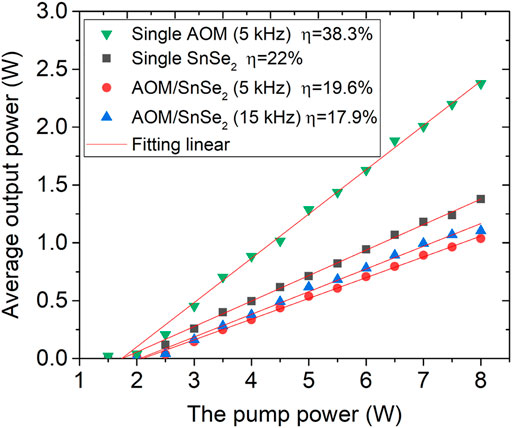
FIGURE 4. Dependence of the average output power on the pump power for AOM singly, SnSe2 singly and AOM/SnSe2 doubly Q-switched lasers with different fA.
The variation of the pulse duration versus the pump power is shown in Figure 5. For Q-switched lasers with single AOM (fA = 5 kHz) and single SnSe2, the shortest pulse durations of 15.8 and 119.4 ns were obtained at the pump power of 8 W, respectively. Here, the pulse durations we obtained are the shortest one ever reported in passively Q-switched lasers with SnSe2 SA [10, 14, 20–23]. To the best of our knowledge, in near-infrared region, the shortest pulse durations of 129 ns was achieved in a passively Q-switched Nd:YAG waveguide laser with SnSe2 SA [10].
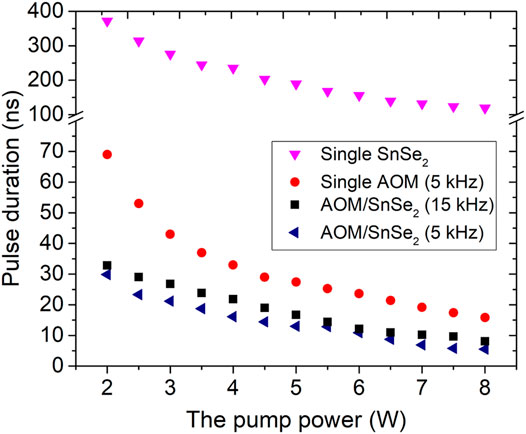
FIGURE 5. Pulse duration versus pump power of SnSe2 singly, AOM singly and AOM/SnSe2 doubly Q-switched lasers with different fA.
For the doubly Q-switched lasers with AOM/SnSe2, the pulse width was much smaller than that of singly Q-switched lasers. The shortest pulse durations of 5.52 and 8.1 ns were obtained at fA = 5 and 15 kHz, respectively. Obviously, a lower repetition rate can bring about a shorter pulse duration. The maximum compression ratio calculated from Figure 5 is approximated to 95.4% from 119.4 ns (in SnSe2 Q-switched lasers) to 5.52 ns (in AOM/SnSe2 Q-switched laser), at 8 W maximum pump powerand fA = 5 kHz. The typically extended temporal profiles of Q-switching pulses at the pump power of 8 W was illustrated in Figure 6. As a solid state laser with free space configuration, the beam quality was measured by the 90.0/10.0 scanning-knife-edge method, the beam quality factors (M2) in the horizontal and longitudinal planes are 1.68/1.38.
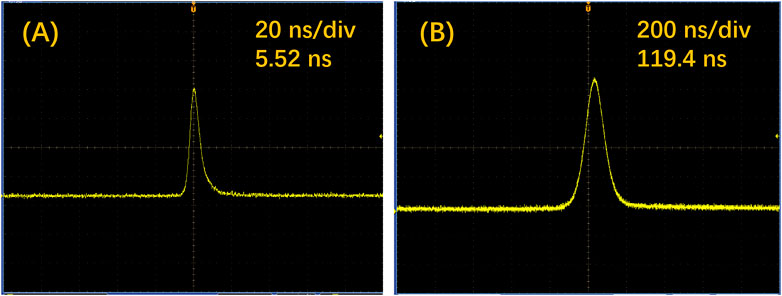
FIGURE 6. The temporal profiles of Q-switching pulses at the pump power of 8 W: (A) double Q-switching; (B) single SnSe2 SA Q-switching.
The pulse repetition rate versus the pump power for SnSe2 singly Q-switched laser was given in Figure 7. The pulse repetition rates varied from 79.6 to 479 kHz within the pump range of 1.5–8 W. The dependences of pulse energies and peak powers on the pump power are depicted in Figure 8. Both pulse energies and peak powers increase monotonically with the increasing of the pump power. Under the maximum pump power of 8 W, 2.8, 475.2, 207.4, and 81.7 μJ pulses energies were achieved for SnSe2 singly, AOM singly (fA = 5 kHz) and AOM/SnSe2 doubly Q-switched lasers at fA = 5 and 15kHz, respectively, corresponding to the peak power of 0.247, 30.1, 37.6, and 10.1 W. The pulse energy of AOM/SnSe2 doubly Q-switched laser (fA = 5 kHz) was 74 times higher than that of SnSe2 singly Q-switched laser. Because of the pulse compression and pulse energy improvement in doubly Q-switched laser, compared with the singly Q-switched laser with SnSe2, the pulse peak power of doubly Q-switched laser with AOM/SnSe2 (fA = 5 kHz) was basically raised 152 times.
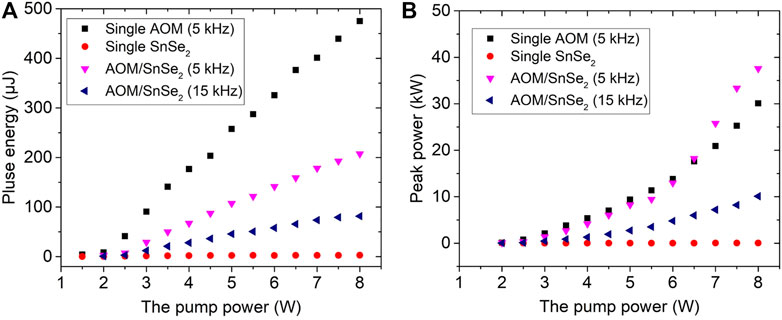
FIGURE 8. (A) Pulse energy and (B) pulse peak power versus pump power of SnSe2 singly, AOM singly and AOM/SnSe2 doubly Q-switched lasers with different fA.
Considering the degradation of optical parameters of SnSe2-SA, in order to check the robustness of SnSe2-SA, the doubly Q-switched laser with AOM and SnSe2-SA was kept operating at the maximum radiation power for at least 6 h every day during 1 week. The fluctuation of the average output power ΔP is measured less than 4.1% at the pump power of 8 W. Besides, no damage and optical degradation of the SnSe2-SA was observed in the experiment.
4 Conclusion
In conclusion, based on the AOM and SnSe2 film, a diode-pumped doubly Q-switched laser with high peak power and adjustable repetition rate was presented. The experimental results show the relations of the pulse width, pulse energy and pulse peak power of the Q-switched pulses versus the repetition rate of AOM and the pump power. In our experiment, the maximum pulse peak power of 37.57 KW with minimum pulse duration of 5.52 ns was obtained with the maximum pump power of 8 W and AOM repetition rate of 5 kHz. A lower repetition rate is conducive to obtaining pulses with high peak power. Compared with the singly passively Q–switched lasers with SnSe2-SA, the pulse characteristics of this doubly Q–switched laser were improved significantly. The experimental results demonstrate that the dual-loss modulation technology is an effective method to compress the pulse width and obtain the pulses with controllable repetition rate and high peak power.
Data Availability Statement
The original contributions presented in the study are included in the article/supplementary material, further inquiries can be directed to the corresponding author.
Author Contributions
JX conceived and designed the experiments, performed the experiments and analysed the data, drafted the manuscript; XD fabricated and characterized the SnSe2 saturable absorber; HY contributed to perform the theoretical analysis, all authors contributed to writing and editing the manuscript. All authors have read and agreed to the published version of the manuscript.
Conflict of Interest
The authors declare that the research was conducted in the absence of any commercial or financial relationships that could be construed as a potential conflict of interest.
Publisher’s Note
All claims expressed in this article are solely those of the authors and do not necessarily represent those of their affiliated organizations, or those of the publisher, the editors and the reviewers. Any product that may be evaluated in this article, or claim that may be made by its manufacturer, is not guaranteed or endorsed by the publisher.
References
1. Salim AA, Bidin N. Pulse Q-Switched Nd:YAG Laser Ablation Grown Cinnamon Nanomorphologies: Influence of Different Liquid Medium. J Mol Struct (2017) 1149:694–700. doi:10.1016/j.molstruc.2017.08.055
2. Lee M-C, Chang C-S, Huang Y-L, Chang S-L, Chang C-H, Lin Y-F, et al. Treatment of Melasma with Mixed Parameters of 1,064-nm Q-Switched Nd:YAG Laser Toning and an Enhanced Effect of Ultrasonic Application of Vitamin C: a Split-Face Study. Lasers Med Sci (2015) 30:159–63. doi:10.1007/s10103-014-1608-2
3. O’Mahony MJ, Simeonidou D, Hunter DK, Tzanakaki A. The Application of Optical Packet Switching in Future Communication Networks. IEEE Commun.Mag. (2001) 39:128–35. doi:10.1109/35.910600
4. Guo B, Xiao QL, Wang Sh., Zhang H. 2D Layered Materials: Synthesis, Nonlinear Optical Properties, and Device Applications. Laser Photon Rev (2019) 13(12):1800327. doi:10.1002/lpor.201800327
5. Zhang B, Liu J, Wang C, Yang K, Lee C, Zhang H, et al. Recent Progress in 2D Material‐Based Saturable Absorbers for All Solid‐State Pulsed Bulk Lasers. Laser Photon Rev (2020) 14:1900240. doi:10.1002/lpor.201900240
6. Dong L, Huang W, Chu H, Li Y, Wang Y, Zhao S, et al. Passively Q-Switched Near-Infrared Lasers with Bismuthene Quantum Dots as the Saturable Absorber. Opt Laser Techn (2020) 128(9):106219. doi:10.1016/j.optlastec.2020.106219
7. Chu H, Pan Z, Wang X, Zhao S, Li G, Cai H, et al. Passively Q-Switched Tm:CaLu0.1Gd0.9AlO4 Laser at 2 μm with Hematite Nanosheets as the Saturable Absorber. Opt Express (2020) 28(11):16893–9. doi:10.1364/oe.395312
8. Zhong H, Yu J, Kuang X, Huang K, Yuan S. Electronic and Optical Properties of Monolayer Tin Diselenide: The Effect of Doping, Magnetic Field, and Defects. Phys Rev B (2020) 101:125430. doi:10.1103/physrevb.101.125430
9. Peng Y, Yu X, Liu W, Lin H, Sun L, Du K, et al. Fast Photoresponse from 1T Tin Diselenide Atomic Layers. Adv Funct Mater (2016) 26:137–45. doi:10.1002/adfm.201670014
10. Cheng C, Li Z, Dong N, Wang J, Chen F. Tin Diselenide as a New Saturable Absorber for Generation of Laser Pulses at 1μm. Opt Express (2017) 25:6132–40. doi:10.1364/oe.25.006132
11. Sun R, Zhang H, Xu N. High-power Passively Q-Switched Yb-Doped Fiber Laser Based on Tin Selenide as a Saturable Absorber. Laser Phys (2018) 28:085105. doi:10.1088/1555-6611/aac531
12. Hu Q, Li M, Li P, Liu Z, Chen X. Dual-wavelength Passively Mode-Locked Yb-Doped Fiber Laser Based on a SnSe2-PVA Saturable Absorber. IEEE Photon J (2019) 11:1503413. doi:10.1109/jphot.2019.2922642
13. Sun W, Tang W, Li X, Jiang K, Wang J, Xia W. Stable Soliton Pulse Generation from a SnSe2-Based Mode-Locked Fiber Laser. Infrared Phys Techn (2020) 110:103451. doi:10.1016/j.infrared.2020.103451
14. Wang M, Wang Z, Xu X, Duan S, Du C. Tin Diselenide-Based Saturable Absorbers for Eye-Safe Pulse Lasers. Nanotechnology (2019) 30:265703. doi:10.1088/1361-6528/ab1115
15. Liu XQ, Yang Q, Zuo CH, Cao YP, Lun XL, Wang PC, et al. 2 μm Passive Q-Switched Tm:YAP Laser with SnSe2 Absorber. Opt Eng (2018) 57(12):126105. doi:10.1117/1.oe.57.12.126105
16. Niu Z, Feng T, Pan Z, Yang K, Li T, Zhao J, et al. Dual-loss-modulated Q-Switched Tm:Ca(Gd,Lu)AlO4 Laser Using AOM and a MoS2 Nanosheet. Opt Mater Express (2020) 10:752–62. doi:10.1364/ome.383015
17. Ma Y, Yu X, Li X, Fan R, Yu J. Comparison on Performance of Passively Q-Switched Laser Properties of Continuous-Grown Composite GdVO_4/Nd:GdVO_4 and YVO_4/Nd:YVO_4 crystals under Direct Pumping. Appl Opt (2011) 50(21):3854–9. doi:10.1364/ao.50.003854
18. Ma Y, Yu X, Li X. Performance Improvement in a Directly 879 Nm Dual-End-π-Polarized-Pumped CW and Pulsed GdVO4/Nd:GdVO4 Laser. Appl Opt (2012) 51(5):600–3. doi:10.1364/ao.51.000600
19. Ma Y, Zhang Y, Yu X, Li X, Chen F, Yan R. Doubly Q-Switched GdVO4/Nd:GdVO4 Laser with AO Modulator and Cr4+:YAG Saturable Absorber under Direct 879nm Diode Pumping to the Emitting Level. Opt Commun (2011) 284:2569–72. doi:10.1016/j.optcom.2011.01.048
20. Ran B, Sun H, Ma Y. Two-dimensional Tin Diselenide Passively Q-Switched 2 μm Tm:YAP Laser. Infrared Phys Techn (2020) 105:103227. doi:10.1016/j.infrared.2020.103227
21. Ma Y, Zhang S, Zhang Z, Liu X, Ding S, Liu W, et al. Continuous Wave and SnSe2/PdSe2 Passively Q-Switched Nd:GdNbO4 Laser under Direct Pumping. Opt Laser Techn (2021) 133:106558. doi:10.1016/j.optlastec.2020.106558
22. Li M, Li Y, Qin X, Tan Y. Ultrafast Absorption of SnSe2-MoS2 Heterojunction Nanosheets and its Application in Passively Q-Switched Nd:GGG Laser. Optik (2019) 189:9–14. doi:10.1016/j.ijleo.2019.04.088
Keywords: solid-state laser, dual-loss modulation, high peak power, SnSe2 saturable absorber, controllable repetition rate
Citation: Xia J, Dong X and Yuan H (2022) Generation of High Peak Power Pulses With Controllable Repetition Rate in Doubly Q-Switched Laser With AOM/SnSe2. Front. Phys. 10:873058. doi: 10.3389/fphy.2022.873058
Received: 10 February 2022; Accepted: 28 February 2022;
Published: 29 April 2022.
Edited by:
Hongwei Chu, Shandong University, ChinaCopyright © 2022 Xia, Dong and Yuan. This is an open-access article distributed under the terms of the Creative Commons Attribution License (CC BY). The use, distribution or reproduction in other forums is permitted, provided the original author(s) and the copyright owner(s) are credited and that the original publication in this journal is cited, in accordance with accepted academic practice. No use, distribution or reproduction is permitted which does not comply with these terms.
*Correspondence: Jingxuan Xia, ZnJlZHhpYTAwMUAxNjMuY29t
 Jingxuan Xia
Jingxuan Xia Xu Dong
Xu Dong